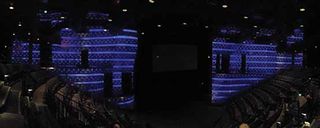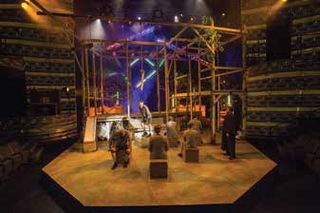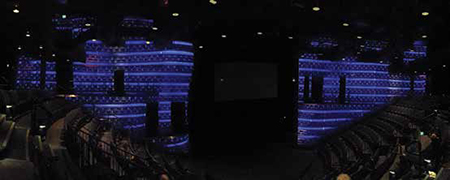
The new Teaching Theatre at the University of Southern Indiana features side walls covered with more than 1,000 LED modules that can irradiate the audience with washes of colors and patterns, furthering the emotive capacity of a production. The protagonist on stage falls into a fit of rage, and the audience is bathed in the red glow of LED lights.
Great stage lighting can transform an average theatre production into a spectacular show: the right combinations of bright light and colors paired with the action can evoke a much deeper emotional response from the audience than a neutrally illuminated stage.
The newly opened theater at the University of Southern Indiana takes lighting a step further, covering the side walls with a system of more than 1,000 LED modules that can irradiate the audience with washes of colors and patterns, furthering the emotive capacity of a production.
These LED walls, created in partnership between lighting designer Chad Groshart of Atelier Ten and Holzman Moss Bottino Architecture, are the most distinctive element of the new 350-seat USI Teaching Theatre, which opened in February 2015. Designed by South Norwalk, CT-based Theatre Projects Consultants and the aforementioned architecture firm, the facility provides students with a high-tech space to both learn and perform dramatic arts.
Measuring approximately 33 feet high, the walls incorporate some 1,100 Philips Color Kinetics iColor Flex nodes, sheathed in a metal mesh, and powered by 39 Philips PDS-60 power supplies. “You can’t see the fixtures themselves; that was part of the intent, to just make the walls come alive with the LED as seen through the perforated metal,” said Steve Rust, senior consultant at Theatre Projects Consultants. “So it was a very custom installation.”
Beyond the LED walls, Theatre Projects Consultants also worked with the architects to design the seating and overall room configuration, catwalk layouts, theater support equipment, rigging, seats, and stage lighting.

The theater’s Philips Strand stage lighting is controlled by Philips’ new NEO console, featuring DMX capability. The main stage lighting system is comprised of Philips Strand products, and everything is controlled by the Philips NEO console, which began shipping just in time.
“The project was originally specified with a Light Palette console, and the Light Palette didn’t have the DMX requirements to control the LED walls,” said Rust. “In the time between the award of the contract and the actual delivery to the construction site, Strand came out with a new console called the NEO, and the NEO console does have the DMX horsepower to run those LED walls. So we were able to change the configuration when Strand was able to provide the new console, they were now able to use that NEO console to control those walls in the auditorium. Before that, they would have just had to trigger presets, so the new system is a huge improvement, where they’re actually able to make the LED walls part of the performances.”
Though the theater is now a top-tier dramatic arts venue, Rust said the space was fundamentally designed with simplicity in mind for the purpose of education. “It’s called the Teaching Theatre, and it really is a theater very much designed for teaching students,” he said. “The theater is set up with a number of readymade scenery, readymade acting locations. There are terraces built into those [LED] walls, so those are readymade areas where someone can do a balcony scene, for example.”
And when it comes to training students to become theater lighting technicians, the University of Southern Indiana has the facility and equipment to rival nearly any institution.
Matt Pruznick is associate editor of SCN and Residential Systems. Follow him on Twitter @Pruznick.











